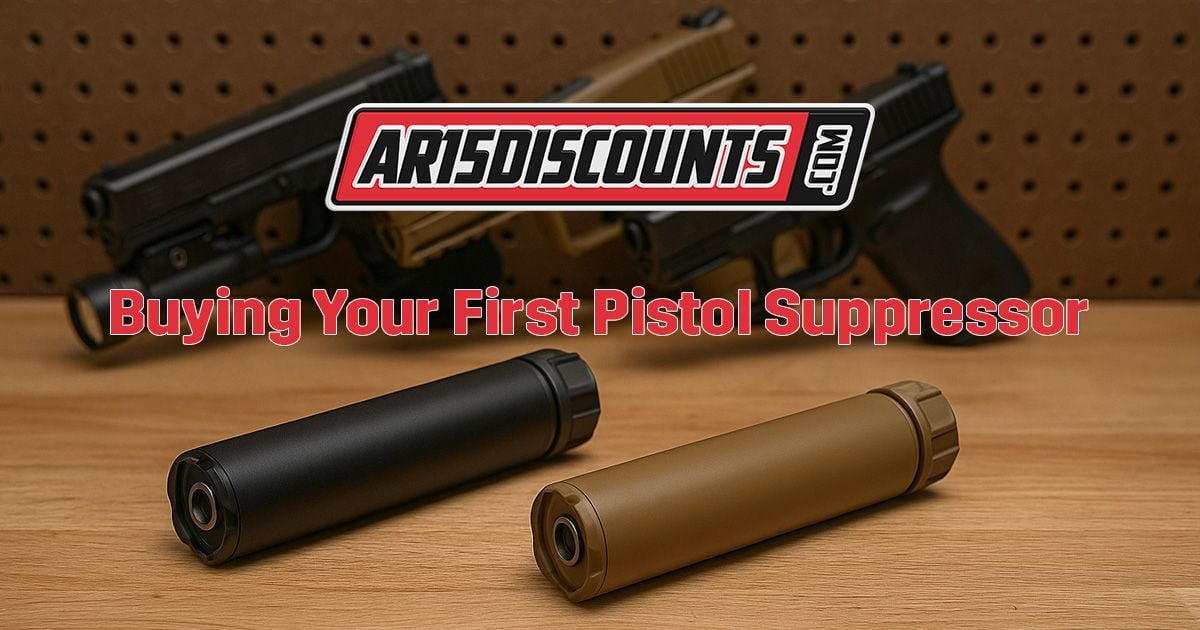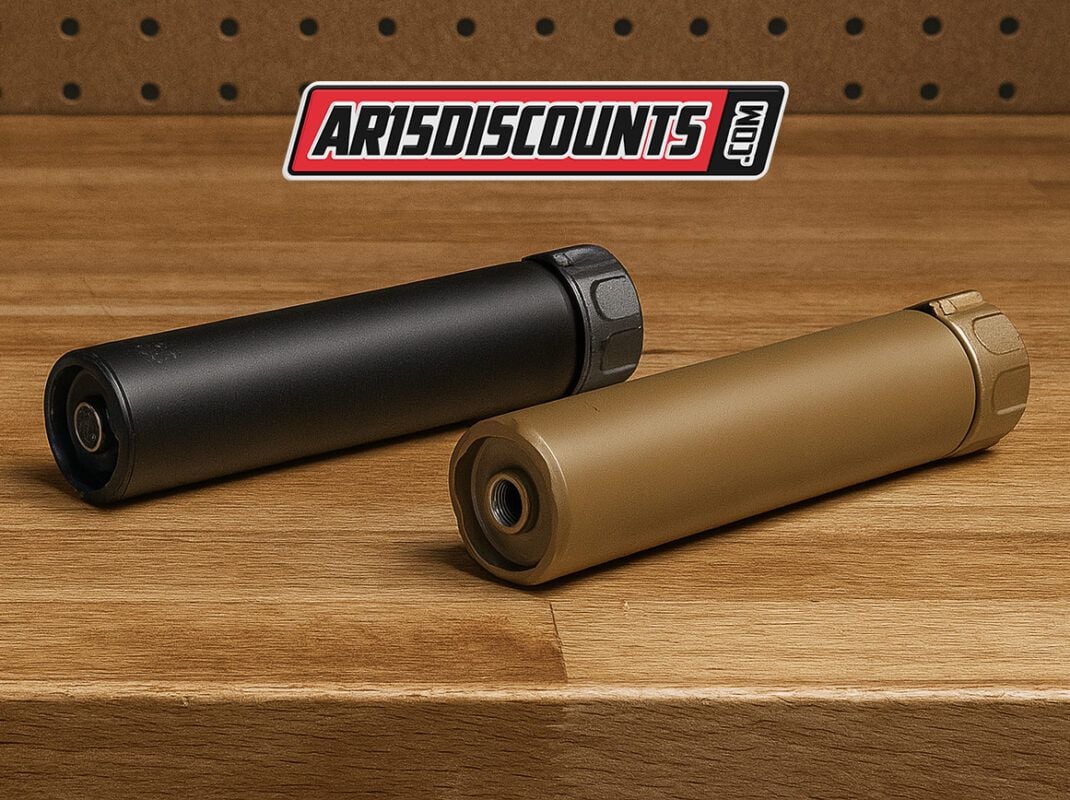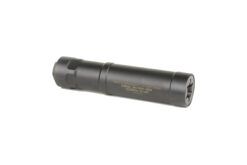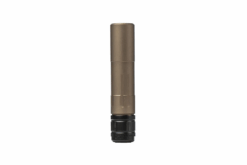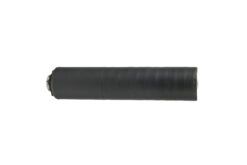NFA
Buying Your First Pistol Suppressor
Table of contents
The Suppressor Revolution: Quieter, Safer, and More Accessible Than Ever
Whether you’re building out a new AR-15 platform, upgrading a precision rifle, or dialing in your home defense setup, one accessory continues to grow in popularity for all the right reasons: the suppressor. Once wrapped in legal ambiguity and cinematic mystique, today’s suppressors are legally owned across much of the U.S. and are easier than ever to purchase and use.
More than just “silencers,” modern suppressors reduce sound signature, tame muzzle blast, and improve overall shooting comfort, making them a favorite among hunters, sport shooters, and tactical enthusiasts. But before you dive into the world of suppressors, it’s essential to understand how they work, what options are available, how to stay compliant with federal and state regulations, and which models best suit your firearm and caliber.
In this guide, we’ll break down everything you need to know: from navigating legal requirements and tax stamps to selecting the right 9mm suppressor, .300 Blackout suppressor, or 22LR suppressor for your setup. You’ll also discover key accessories like suppressor covers, alignment rods, and wraps, plus a roundup of top-rated brands like Rugged Suppressors, Q Suppressors, SureFire, and more.
Let’s get into it—because your next suppressed shot is closer than you think.
What Is a Suppressor and How Does It Work?
A suppressor, often mistakenly called a silencer, is a firearm accessory designed to reduce the sound and visual signature of a gunshot. While both terms are used interchangeably, “suppressor” is the more accurate term. It doesn’t make firearms “silent” but instead suppresses the noise, flash, and concussion produced when a gun is fired.
So, how does a suppressor work? The mechanics are relatively straightforward but highly effective. When you fire a round, high-pressure gases are expelled rapidly from the barrel behind the bullet. A suppressor is essentially a sealed metal tube—often made from stainless steel, titanium, or aluminum—containing a series of internal baffles. These baffles slow down and redirect those expanding gases, allowing them to cool before exiting the muzzle. By controlling the rate and direction of the gas expansion, the suppressor significantly reduces the intensity of the sound that follows a gunshot.
The benefits go beyond just hearing protection. Suppressors also help reduce felt recoil, making it easier to stay on target during rapid fire. Additionally, they minimize muzzle flash, which is crucial in low-light or tactical environments where flash signature can give away a shooter’s position.
Whether you’re running a 9mm suppressor, .22 suppressor, or a .300 blackout suppressor, the core technology remains the same—redirecting, slowing, and cooling expanding gases to enhance shooting comfort, performance, and stealth. Suppressors are a brilliant addition to any firearm setup, especially when chosen for the right caliber and use case.
Are Suppressors Legal in the U.S.?
One of the most common questions surrounding suppressors is: “Are suppressors illegal?” The short answer is no—suppressors are legal in most states, but they are regulated under federal law. That said, the process of buying and owning one requires navigating some specific legal steps.
So, “Are suppressors legal?” Yes—but only if you follow the guidelines established by the National Firearms Act (NFA). Enacted in 1934, the NFA classifies suppressors (along with short-barreled rifles and machine guns) as regulated items. To legally own a suppressor, you must:
- Be at least 21 years old.
- Live in a state where suppressor ownership is legal.
- Pass a federal background check.
- Submit ATF Form 4 and pay a one-time $200 tax stamp.
- Receive approval from the Bureau of Alcohol, Tobacco, Firearms and Explosives (ATF).
Currently, 42 states allow civilian ownership of suppressors, including Texas, Florida, Arizona, Utah, and Georgia. However, they remain illegal in states like California, New York, New Jersey, Illinois, and Hawaii. Always check your local and state laws before applying.
What about pistol suppressors? As long as your state allows suppressors and you follow the same federal process, they are just as legal as rifle suppressors. Many shooters choose models like the Obsidian 9 suppressor for their compatibility with Glock, CZ, and other popular handguns.
Looking to purchase? Explore a wide range of options now at the Suppressor Collection on AR15Discounts.com to find legal suppressors for your state and firearm setup.
How to Buy a Suppressor: Step-by-Step
If you’re wondering how to buy a suppressor, the process is more straightforward than many people think. While it does involve federal paperwork and a wait time, thousands of Americans legally purchase suppressors each year. Here’s a clear breakdown:
Step 1: Confirm State Legality
Before anything else, verify that suppressors are legal in your state. Ownership is permitted in 42 states, but places like California, New York, and Illinois still prohibit civilian use.
Step 2: Choose Your Suppressor
Select a suppressor that matches your firearm type and caliber. Whether you’re looking for a 9mm suppressor, a .300 BLK suppressor, or a multi-cal option, make sure the suppressor is compatible. Visit the AR15Discounts Suppressor Collection for top-rated options.
Step 3: Find a Dealer or Kiosk
Once you’ve chosen your suppressor, you’ll need to purchase it through an FFL/SOT dealer. Many people use Silencer Shop kiosks for convenience—they handle much of the paperwork and offer digital fingerprinting.
Step 4: Submit ATF Paperwork
Yes, you do need a tax stamp to buy a suppressor. You’ll fill out ATF Form 4, provide fingerprints and a photo, and pay the one-time $200 fee. You can register as an individual, trust, or corporation.
Step 5: Wait for Approval
How long does it take to get a suppressor? Approval times vary, but eForms are helping to expedite the process. While traditional paper forms can take 8–12 months, eForm submissions often come back in 3–6 months.
Step 6: Take Possession
Once approved, you’ll receive your tax stamp and be able to take your suppressor home legally.
What is a suppressor? It’s a device designed to reduce firearm noise. However, be aware that making a suppressor at home without approval is a federal felony. Always go through the proper legal process.
Now that you know how to get a suppressor, you’re one step closer to enjoying quieter, more controlled shooting.
Suppressor Types and Compatibility
Choosing the right suppressor depends heavily on the caliber and type of firearm. Suppressors aren’t one-size-fits-all; each is designed to handle specific pressures, volumes, and heat levels, depending on the cartridge. Below is a breakdown of popular suppressor types by caliber, along with recommendations for first-time buyers.
9mm Suppressor
A 9mm suppressor is ideal for handguns and pistol-caliber carbines. These suppressors are compact, lightweight, and built to handle subsonic 9mm ammo, which helps maximize noise reduction. Popular models include the Obsidian 9 suppressor, known for its modular design and superior sound suppression.
.300 Blackout Suppressor
The .300 blackout suppressor is a favorite among AR-15 builders for its compatibility with both subsonic and supersonic loads. Suppressors designed for .300 BLK are often optimized for reduced gas blowback and work well with shorter barrels.
.308 and 30 Cal Suppressor
A .308 suppressor or 30 cal suppressor covers a wide range of calibers, including .308 Win, 6.5 Creedmoor, and .300 Win Mag. These suppressors are built to withstand high pressures and are excellent for long-range and hunting applications.
22LR Suppressor / 22 Suppressor
A 22LR suppressor (also known as a 22 suppressor) is incredibly quiet and ideal for rimfire plinking or varmint hunting. They’re typically lightweight, user-serviceable, and budget-friendly.
Shotgun Suppressor
Although less common, shotgun suppressors are available for 12-gauge platforms and are gaining popularity for home defense and tactical use.
Multi-Caliber Suppressors
Multi-cal suppressors offer flexible use across multiple platforms. Many first-time buyers opt for these because they work with various calibers, which saves money and reduces redundancy. Brands like Rugged Suppressors and Q Suppressors make excellent modular options.
Best Caliber for First-Time Suppressor Buyers
So, what’s the best caliber for a first-time suppressor buyer? Most experts recommend starting with either the 9mm or .22 LR. These calibers offer affordable ammo, easy pairing with pistols or PCCs, and excellent suppression performance, especially when paired with subsonic rounds.
Special Compatibility Note: CZ P-10 C Suppressor-Ready Urban Gray
If you own the P-10 C suppressor-ready urban gray, you’re in luck. This platform is specifically threaded to accept the most popular 9mm suppressors, making it a turnkey option for pistol suppression setups. Be sure to verify the thread pitch and booster compatibility.
Understanding caliber-specific suppressors is the key to matching the right can to your gun. With the proper fit, you’ll enjoy quieter, more controlled shooting across any platform.
Suppressor Mounting Systems Explained
Mounting your suppressor properly is just as important as choosing the right caliber. A poorly mounted suppressor can result in dangerous misalignment, reduced performance, or even damage to your firearm. Here’s what you need to know about the most common suppressor mounting systems and how to ensure safe, effective installation across platforms like AR-15s and handguns.
Direct-Thread vs. Quick Detach (QD) Suppressors
The two most common mounting styles are direct-thread and quick detach (QD).
- Direct-thread suppressors screw directly onto the threaded muzzle of your firearm. This method is simple, secure, and ideal for precision rifles or firearms that won’t frequently swap suppressors. It minimizes point-of-impact shift and is generally more affordable.
- QD suppressors attach to a specialized muzzle device, like a flash hider or brake. They’re designed for speed, allowing you to remove or switch cans between rifles without the need for tools. This is ideal for tactical setups or multi-platform use, but can introduce slight shifts in zero depending on the system.
What Is a Booster or Nielsen Device?
A booster (also called a Nielsen device) is essential for many handgun suppressors. It temporarily decouples the suppressor from the barrel during recoil, allowing semi-automatic pistols with tilting barrels, such as Glock or CZ models, to cycle correctly. Without a booster, your handgun may malfunction or fail to eject.
“What’s the Difference Between Direct-Thread and Booster Suppressors?”
- Direct-thread suppressors are usually fixed and work best on rifles or fixed-barrel pistols.
- Booster-equipped suppressors are necessary for cycling tilt-barrel handguns and must be chosen accordingly.
When in doubt, always match your suppressor’s mounting type to the firearm’s barrel system.
Suppressor Alignment Rods: Safety First
Using a suppressor alignment rod is highly recommended, especially on builds where tolerances may vary. These rods help ensure your suppressor is concentric with the bore, preventing baffle strikes that could damage your can or firearm. This is especially important for AR-15 suppressor setups, where mounting systems may vary slightly between brands or have different thread specifications.
Whether you’re suppressing a Glock, AR-15, or CZ P-10 C, understanding mounting systems is crucial for safety, performance, and overall satisfaction with your suppressor setup.
Suppressor Accessories You’ll Want
Once you’ve selected your suppressor, a few bright accessories can make a significant difference in how it performs and feels during use. From heat protection to simple add-ons, these items are worth considering.
Suppressor Covers & Wraps
When you shoot with a suppressor, it heats up quickly—sometimes enough to burn you or cause a mirage (a wave-like blur in your sight picture). That’s where suppressor covers and suppressor wraps come in. These sleeves go over the suppressor to:
- Reduce the heat you feel on your hands
- Cut down on the blurry mirage in your optic
- Keep your suppressor cooler for longer shooting sessions
Popular options include CAT suppressor covers, known for their durable materials, and B&T suppressor accessories, which are made specifically for their lineup of cans. These wraps are handy for people who shoot often or run multiple mags in a row.
What’s a Surge Suppressor Outlet?
You may also encounter the term surge suppressor while shopping, but be aware that it is not related to firearm accessories. A surge suppressor outlet is used for electronics, like a power strip, that protects your TV or computer from voltage spikes. It has nothing to do with firearm suppressors, even though the words are similar.
If you plan on using your suppressor often, adding a suppressor cover or wrap is a small investment that protects your gear, keeps you safe, and helps maintain better accuracy downrange.
Performance Insights
When adding a suppressor to your firearm, it’s normal to wonder how it affects performance. Let’s break down some common questions and clear up a few myths.
Does a Suppressor Affect Accuracy or Velocity?
Yes—but not always in the way you might expect. In many cases, a suppressor can enhance accuracy by reducing recoil and muzzle rise, allowing you to stay on target more effectively. However, if the suppressor is mounted incorrectly or is slightly off-center, it can hurt accuracy. That’s why it’s essential to use tools like alignment rods when installing.
As for velocity, suppressors may slightly increase it because they contain expanding gases a bit longer, giving the bullet more push. But the change is usually small—just a few feet per second—not enough to impact your shooting in most cases.
How Much Quieter Is a Suppressor?
Suppressors can lower the sound of a gunshot by 20 to 35 decibels, depending on the firearm and ammo. This is a significant improvement, but it won’t make your gun “silent.”
Are Suppressors Truly Silent?
No—that’s a Hollywood myth. While a suppressor makes shooting noticeably quieter, you’ll still hear a loud pop, especially with supersonic ammo. What it does do is take the edge off the noise, making it safer for your ears and less disruptive to those around you.
Do I Need Subsonic Ammo to Use a Suppressor?
Not always, but subsonic ammo helps reduce noise even more. Supersonic bullets break the sound barrier, creating a loud crack. Subsonic rounds stay below that speed, avoiding the sonic boom and making shots much quieter. They’re handy in 9mm suppressor or .300 blackout suppressor setups optimized for stealth.
Best Suppressor Brands to Know
If you’re new to the world of suppressors, finding a reliable brand can feel overwhelming. To help narrow your choices, here are some of the top brands for first-time suppressor buyers, known for consistent performance, durable construction, and broad compatibility across rifles and pistols.
- Wilson Combat is renowned for its modular suppressors and battle-ready durability. Popular for their versatility across multiple calibers and host firearms, especially in pistol and rifle setups.
- Dead Air Armament: Dead Air continues to lead the suppressor industry with options like the Nomad and Sandman series. These suppressors offer outstanding sound suppression, durable construction, and user-friendly mounting systems, making them ideal for both precision and tactical builds.
- Griffin Armament: Griffin offers a wide range of suppressors designed for AR platforms, including the Paladin and Recce series. They are well-regarded for their performance, modularity, and user-serviceable designs.
- SureFire: Built to exceed military standards, SureFire suppressors—especially the SOCOM series—are favored for their minimal point-of-impact shift, rugged reliability, and compatibility with AR-style rifles used in duty or defensive applications.
- Aero Precision: Better known for AR parts, Aero Precision has entered the suppressor market with designs that reflect their reputation for tight tolerances and rock-solid engineering, making them a solid choice for those seeking streamlined AR builds.
- Odin Works: Odin Works suppressors are purpose-built for modularity and compatibility with their extensive lineup of AR components. Their suppressors are a strong fit for both performance-focused shooters and DIY builders.
- HUXWRX: HUXWRX (formerly OSS Suppressors) is recognized for its Flow-Through technology, which significantly reduces gas blowback and enhances shooter comfort. Ideal for semi-auto rifles where overgassing is a concern.
- SilencerCo: A significant name in the suppressor space, SilencerCo delivers popular models like the Omega and Hybrid, which are renowned for their versatility across various calibers and host platforms. Their reputation for innovation and build quality makes them a top-tier option for any shooter.
Each of these brands brings something unique to the table, and serious shooters trust all. Whether you’re looking for durability, modularity, or a lightweight design, AR15Discounts.com offers the best in the industry.
FAQs About Suppressors
Whether you’re new to suppressors or need clarity on legalities, compatibility, or maintenance, our Suppressor FAQ covers the most common questions to help you make an informed purchase and stay compliant.
Yes, it is legal to own a pistol suppressor in 42 U.S. states, provided you follow the federal process under the National Firearms Act (NFA), which includes passing a background check, submitting ATF paperwork, and paying a $200 tax stamp. Always check your state laws before purchasing.
Yes. Every suppressor purchase requires a $200 tax stamp issued by the ATF. This is a one-time fee and part of the registration process under the NFA.
Approval times vary. Paper submissions can take 8–12 months, while eForms are often processed in 3–6 months. Processing times can fluctuate depending on the volume of ATF and the accuracy of the paperwork.
Direct-thread suppressors screw directly onto the barrel and are ideal for rifles or fixed-barrel pistols. Boosters, also known as Nielsen devices, are required for most semi-automatic pistols to help cycle the action by temporarily decoupling the suppressor during recoil.
Yes, many suppressors are designed to be used on multiple firearms, as long as the thread pitch and caliber are compatible. Swapping pistons or mounts may be necessary for proper fit and function.
Suppressors can slightly increase velocity and often improve accuracy by reducing recoil and muzzle rise. However, improper alignment can negatively impact performance.
.22LR and 9mm are two of the most popular and beginner-friendly calibers. They offer excellent noise suppression, affordable ammo, and broad compatibility with popular firearms.
No. While suppressors significantly reduce noise, they don’t make firearms completely silent. The term “silencer” is misleading—there’s still a noticeable sound, especially with supersonic ammunition.
No, but subsonic ammo helps reduce noise even further by eliminating the sonic crack. It’s especially beneficial in .300 Blackout, 9mm, and .22 LR setups where quiet performance is a priority.
Conclusion: Your Path to a Quieter, Smarter Shooting Experience Starts Here
Suppressors are no longer a niche accessory—they’re a smart upgrade for shooters who value performance, safety, and versatility. Whether you’re running subsonic 9mm, hunting with .308, or dialing in a suppressed AR-15 build, the proper suppressor setup makes a measurable difference. With the appropriate knowledge and legal steps, owning a suppressor is easier than ever. AR15Discounts.com makes it simple to find caliber-specific suppressors, trusted brands, and must-have accessories—all in one place.
Shop suppressors and accessories now at AR15Discounts.com—where top-tier gear meets unbeatable value.
Additional resources, www.dirtybirdusa.com

